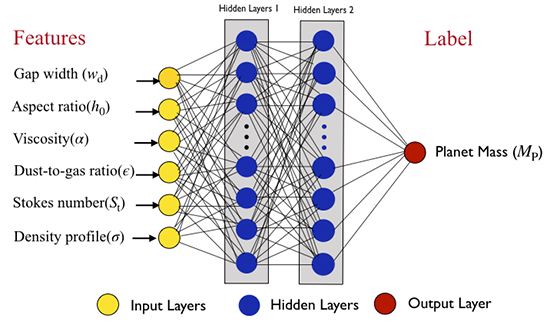Research Gallery > The Theoretical Astrophysics (Theory)
Research Gallery
The Theoretical Astrophysics (Theory)
| Finding planets using Machine Learning |
|
Image Credit: Auddy & Lin (2020, ApJ)

A schematic diagram of the DPNNet (Disk Planet Neural Network) using a fully connected multi-layer perceptron. The first layer in yellow takes as input six feature variables observed from the protoplanetary disk. The output layer in red gives the planet mass as a target variable.
|
| Finding exoplanets can be hard. Even with the advanced planet search schemes detecting planets around young stars are not easy. The planet signatures like spectra or light curves are often suppressed due to enhanced stellar activity. Thus one has to depend on indirect evidences (like the dust gaps and rings) to ascertain the presence of such "Unseen Planets". In this new work done in collaboration with Dr. Min-Kai Lin at ASIAA, we design a neural network called DPNNet (Disk Planet Neural Network) that can find and predict the mass of these unseen planets from protoplanetary disks observed by ALMA. DPNNet uses deep learning (a sub-branch of Machine learning) to learn the underlying relationship between the planetary gaps in dust and the complex disk-planet interaction. It is trained using ~1000 simulations of disk-planet interaction using FARGO3D code. |
 asiaa.sinica.edu.tw Media Request: epo
asiaa.sinica.edu.tw Media Request: epo asiaa.sinica.edu.tw
asiaa.sinica.edu.tw 
